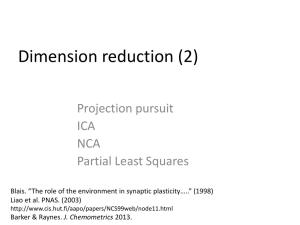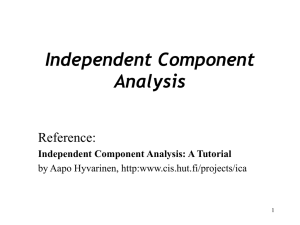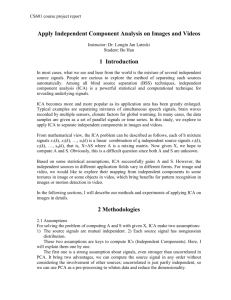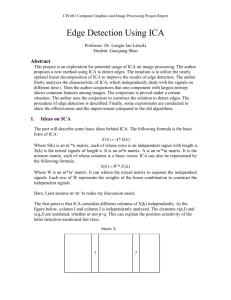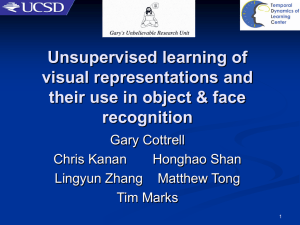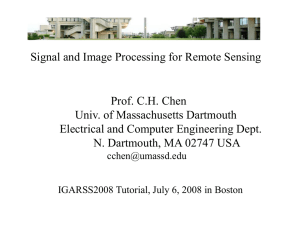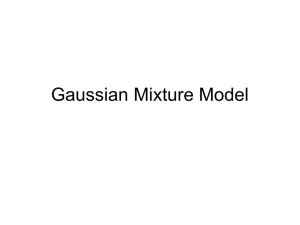Independent Component Analysis
advertisement
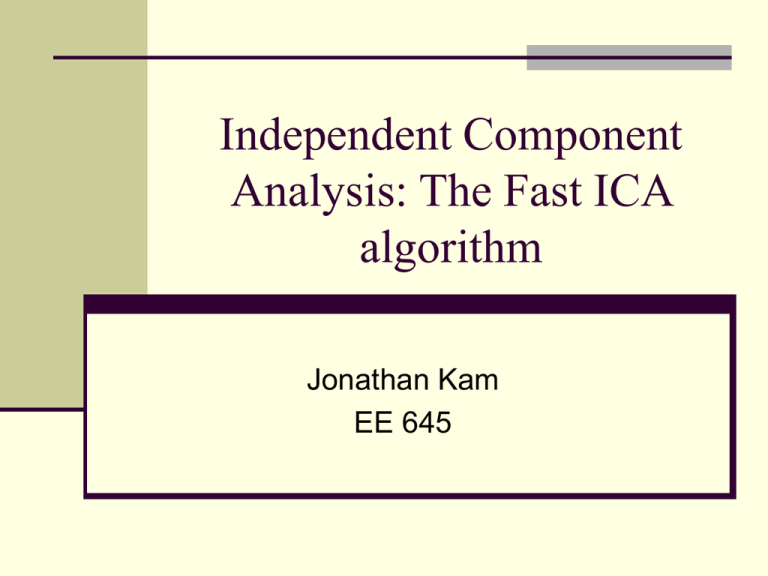
Independent Component
Analysis: The Fast ICA
algorithm
Jonathan Kam
EE 645
Overview
The Problem
Definition of ICA
Restrictions
Ways to solve ICA
NonGaussianity
Mutual Information
Maximum Likelihood
Fast ICA algorithm
Simulations
Conclusion
The Problem
Cocktail Problem
Several Sources
Several Sensors
Ex: Humans hear mixed signal, but able to
unmix signals and concentrate on a sole
source
Recover source signals given only mixtures
No prior knowledge of sources or mixing
matrix
aka Blind Source Separation (BSS)
Assumptions
Source signals are statistically independent
Knowing the value of one of the components
does not give any information about the others
ICs have nongaussian distributions
Initial distributions unknown
At most one Gaussian source
Recovered sources can be permutated and
scaled
Definition of ICA
Observe N linear mixtures x1,…,xn of n
independent components
xj = aj1s1 + aj2s2 + … + ajnsn, for all j
aj is the column of the mixing matrix A
Assume each mixture xj and each IC sk is a
random variable
Time difference between mixes dropped
Independent components are latent variables
Cannot be directly observed
Definition of ICA
ICA Mixture model: x=As
A is mixing matrix; s is matrix of source signals
Goal
Find some matrix W, so that
s = Wx
W = inverse of A
Definition: Independence
Two functions independent if
E{h1(y1)h2(y2)} = E{h1(y1)} E{h2(y2)}
If variables are independent, they are
uncorrelated
Uncorrelated variables
Defined: E{y1y2} = E{y1} E{y2} = 0
Uncorrelation doesn’t equal independence
Ex: (0,1),(0,-1),(1,0),(-1,0)
E{y12y22} = 0 ≠ ¼ = E{y12} E{y22}
ICA has to prove independence
ICA restrictions
Cannot determine variances
s and A are unknown
Scalar multipliers on s could be canceled out
by a divisor on A
Multiplier could even be -1
Cannot determine order
Order of terms can changed.
ICA restrictions
At most 1 Gaussian source
x1 and x2 Gaussian, uncorrelated, and unit
variance
x 12 x 22
p( x1 , x 2 )
exp
2
2
1
Density function is completely symmetric
Does not contain info on direction of the columns
of the mixing matrix A.
ICA estimation
Nongaussianity estimates independent
Estimation of y = wT x
let z = AT w, so y = wTAs = zTs
y is a linear combination of si, therefore zTs is more
gaussian than any of si
zTs becomes least gaussian when it is equal to one of
the si
wTx = zTs equals an independent component
Maximizing nongaussianity of wTx gives us one of the
independent components
Maximizing nongaussianity by measuring
nongaussiantiy
Minimizing mutual information
Maximum Likelihood
Measuring nongaussianity
Kurtosis
Fourth order cumulant
Classical measure of nongaussianity
kurt(y) = E{y4} – 3(E{y2})2
For gaussian y, fourth moment = 3(E{y2})2
Kurtosis for gaussian random variables is 0
Con – not a robust measure of nongaussianity
Sensitive to outliers
Measuring nongaussianity
Entropy (H): degree of information that an
observation gives
H (Y ) P (Y a i ) log P (Y a i )
i
A Gaussian variable has the largest entropy
among all random variables of equal variance
Negentropy J
Based on the information theoretic quantity of
differential entropy
J (Y ) H y gauss H y
Computationally difficult
Negentropy approximations
Classical method using higher-order
moments
J ( y)
1
12
E y
3 2
1
kurt ( y )
2
48
Validity is limited to nonrobustness of kurtosis
Negentropy approximations
Hyvärinen 1998b: maximum-entropy principle
J ( y ) E G ( y ) E G ( v )
2
G is some contrast function
v is a Gaussian variable of zero mean and unit
variance
Taking G(y) = y4 makes the equation kurtosis
based approximation
Negentropy approximations
Instead of kurtosis function, choose a contrast
function G that doesn’t grow too fast
G 1 u
1
a1
log cosh a 1 u , G 2 u exp u / 2
Where 1≤a1≤2
2
Minimizing mutual information
Mutual information I is defined as
m
I ( y 1 , y 2 ,..., y m )
H(y
i
) H ( y)
i 1
Measure of the dependence between random
variables
I = 0 if variables are statistically independent
Equivalent to maximizing negentropy
Maximum Likelihood Estimation
Closely related to infomax principle
Infomax (Bell and Sejnowski, 1995)
Maximizing the output entropy of a neural
network with non-linear outputs
Densities of ICs must be estimated properly
If estimation is wrong ML will give wrong
results
Fast ICA
Preprocessing
Fast ICA algorithm
Maximize non gaussianity
Unmixing signals
Fast ICA: Preprocessing
Centering
Subtract its mean vector to make x a zeromean variable
ICA algorithm does not need to estimate the
mean
Estimate mean vector of s by A-1m, where m is
the mean the subtracted mean
Fast ICA: Preprocessing
Whitening
Transform x so that its components are
uncorrelated and their variances equal unity
the covariance
~x
~T I
E x
matrix of ~
x equals the identity
matrix
Use eigen-value decomposition (EVD) of the
covariance matrix E
~ ED
x
1 2
T
E x
D is the diagonal matrix of its eigenvalues
E is the orthogonal matrix of eigenvectors
Fast ICA: Preprocessing
Whitening
Transforms the mixing matrix into Ã.
x~ ED
1 2
~
E As A s
T
Makes à orthogonal
Lessons the amount of parameters that have to
be estimated from n2 to n(n-1)/2
In large dimensions an orthogonal matrix contains
approximately ½ the number of parameters
Fast ICA Algorithm
One-unit (component) version
1. Choose an initial weight vector w.
2. Let w+ = E{xg(wTx)} – E{g′(wTx)}w
Derivatives of contrast functions G
g1(u) = tanh(a1u),
g2(u) = u exp (-u2/2)
3. w = w+/||w+||. (Normalization step)
4. If not converged go back to 2
-converged if norm(wnew – wold) > ξ or norm(woldwnew)> ξ
- ξ typically around 0.0001
Fast ICA Algorithm
Several unit algorithm
Define B as mixing matrix and B′ as a matrix
whose columns are the previously found
columns of B
Add projection step before step 3
Step 3 becomes
3. Let w(k) = w(k) - B′B′Tw(k). w = w+/||w+||
Simple Simulation
Separation of 2 components
Figure 1: Two independent non gaussian wav
samples
Simple Simulation
Figure 2: Mixed signals
Simple Simulation
Recovered signals vs original signals
Figure 3: Recovered signals
Figure 4: Original signals
Simulation Results
IC 1 recovered in 6 steps and IC 2 recovered
in 2 steps
Retested with 20000 samples
Requires approximately the same number of
steps
Gaussian Simulation
Figure 5: 2 wav samples and noise signal
Gaussian Simulation
Figure 6: 3 mixed signals
Gaussian Simulation
Comparison of recovered signals vs original
signals
Figure 7: Recovered signals
Figure 8: Original signal
Gaussian Simulation 2:
Tried with 2 gaussian components
Figure 10: Original signals
Figure 11: Recovered signals
Components were not estimated properly due
to more than one Gaussian component
Conclusion
Fast ICA properties
No step size, unlike gradient based ICA algorithms
Finds any non-Gaussian distribution using any non
linear g contrast function.
Components can be estimated one by one
Other Applications
Separation of Artifacts in image data
Find hidden factors in financial data
Reduce noise in natural images
Medical signal processing – fMRI, ECG, EEG
(Mackeig)
References
[1] Aapo Hyvärinen and Erkki Oja, Independent Component Analysis:
Algorithms and Applications. Neural Networks Research Centre
Helsinki University of Technology; Neural Networks, 13 (4-5): 411-430,
2000
[2] Aapo Hyvärinen and Erkki Oja, A Fast Fixed-Point Algorithm for
Independent Component Analysis. Helsinki University of Technology
Laboratory of Computer and Information Science, Neural Computation,
9:1483:1492, 1997
[3] Anthony J. Bell and Terrence J. Sejnowski, The ‘Independent
Components’ of Natural Scenes are Edeg Filters. Howard Hughes
Medical Institute Computational Neurobiology Laboratory
[4] Te-Won Lee, Mark Girolami, Terrence J. Sejnowski, Independent
Component Analysis Using and Extended Infomax Algorithm for Mixed
Subgaussian and Supergaussian Sources. 1997
[5] Antti Leino, Independent Component Analysis An Overview. 2004
[6] Erik G. Learned-Miller, John W. Fisher III, ICA Using Spacings
Estimates of Entropy Journal of Machine Learning Research 4 (2003)
1271-1295.


